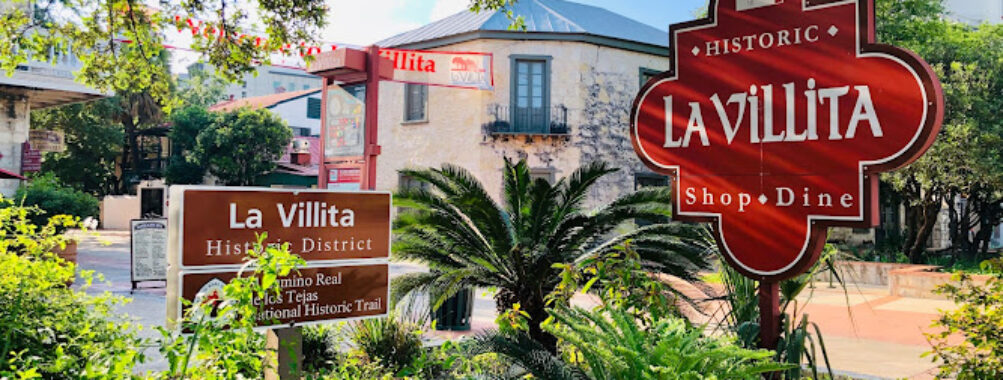
La Villita Historic Village
Description
Just steps from San Antonio’s famous River Walk, La Villita Historic Arts Village stands as one of the city’s most charming cultural treasures. This [square-block enclave](https://www.sanantonio.gov/Mission-Trails/Mission-Trails-Historic-Sites/Historic-Districts-Neighborhoods/La-Villita-Historic-District) features 27 historic buildings that tell the story of San Antonio’s evolution from a humble Spanish settlement to the dynamic city it is today. Originally a [Coahuiltecan Indian village](https://texastimetravel.com/directory/la-villita-historic-arts-village/), La Villita transformed through the centuries, housing Spanish soldiers, European craftsmen, and Mexican families who shaped the neighborhood’s unique architectural character.
Today, these preserved structures host an eclectic mix of art galleries, specialty shops, and restaurants. What I love most about this place is how it feels like stepping into a small European village, with its winding stone pathways and intimate courtyards. The buildings themselves showcase a fascinating blend of [Spanish, European, and American architectural influences](https://texastimetravel.com/directory/la-villita-historic-arts-village/), from stucco-covered brick homes to German vernacular structures.
Key Features
• Historic Architecture: Twenty-seven preserved 19th-century buildings representing San Antonio’s diverse cultural heritage
• Art Galleries: Local artisans showcase and sell handcrafted jewelry, pottery, textiles, and paintings
• Cultural Events: Regular art shows, festivals, and cultural celebrations throughout the year
• Dining Options: Unique restaurants offering both traditional and contemporary cuisine
• Shopping: Specialty boutiques featuring handmade crafts and local artworks
• Outdoor Spaces: Beautiful courtyards and plazas perfect for relaxing or photography
• Free Admission: [Open to the public at no cost](https://thesanantoniothings.com/la-villita-historic-arts-village/)
Best Time to Visit
I’ve found that spring (March to May) and fall (September to November) offer the most pleasant weather for exploring La Villita. The temperatures are mild, and the crowds are manageable. Early mornings or late afternoons provide the best lighting for photography and a more relaxed atmosphere. Weekdays tend to be less crowded than weekends, giving you more time to chat with artists and shop owners.
If you’re into cultural events, plan your visit during one of the many festivals. December is particularly magical with holiday decorations and special events, though you’ll need to bundle up a bit. Summer months can get pretty toasty, so if you’re visiting then, I’d suggest coming early in the day and bringing plenty of water.
How to Get There
La Villita is super easy to access from downtown San Antonio. It’s right off the River Walk, which makes it perfect for combining with other downtown attractions. If you’re driving, there are several parking garages and lots nearby, though they can get pricey during peak times. I usually park a few blocks away where rates are better and enjoy the short walk.
The VIA Metropolitan Transit system has multiple stops nearby if you’re using public transportation. Rideshare services like Uber and Lyft are also readily available. Walking from major downtown hotels or the Alamo takes just a few minutes, and the stroll along the River Walk is part of the experience.
Tips for Visiting
Wear comfortable walking shoes – those historic stone pathways are gorgeous but can be uneven. I learned this the hard way my first visit! Take your time exploring the different buildings and don’t hesitate to chat with the artists and shop owners. They often share fascinating stories about the village’s history and their craft.
Bring a camera – the architecture and courtyards make for amazing photo opportunities. The lighting is particularly beautiful in the early morning or late afternoon. Some shops may have limited hours, so checking ahead is smart if you’re interested in specific galleries or stores.
Consider bringing cash, as some smaller vendors might prefer it. While most places accept cards, having cash on hand is always good. If you’re visiting during summer, bring water and plan for indoor breaks in the air-conditioned galleries.
The dining options here are worth exploring, but they can get busy during peak lunch hours. I’ve found that eating a bit earlier or later than the usual rush gives you a more relaxed experience. And don’t forget to look up event schedules – there’s often something special happening that could make your visit even more memorable.
Make sure to venture off the main pathways – some of the most interesting spots are tucked away in corners you might miss at first glance. And if you’re into history, take time to read the historical markers scattered throughout the village. They tell fascinating stories about the buildings and the people who once lived here.
This place really comes alive during cultural events and festivals, but these can also be the busiest times. If you’re visiting during a festival, arrive early to beat the crowds and secure parking. The trade-off is worth it though – the energy during these events is incredible and you’ll get to experience local culture at its finest.
Table of Contents
Location
Places to Stay Near La Villita Historic Village
Find and Book a Tour
Explore More Travel Guides
No reviews found! Be the first to review!